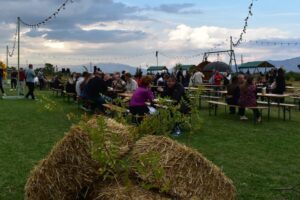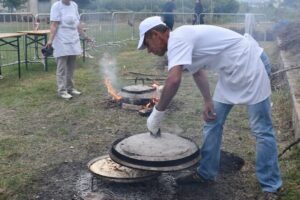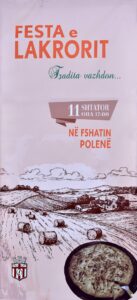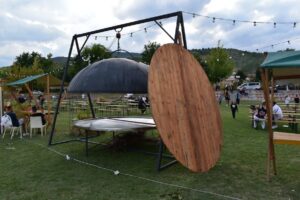Lakrori’s Feast is an old traditional event handed down from generation to generation in Korça district. The focus of this feast is the traditional Korça food, namely the two-filo dough lakrori, a moist pastry pie baked in saç (a covered, large shallow pan). The aim of this feast is to celebrate and preserve the culinary values in this district and also to promote it to local and foreign tourists. The feast is hosted with the support of Korça Municipality during the August-September period when many local housekeepers prepare dozens of two filo dough lakror. What makes this feast exceptional is not only selling lakrori, but baking it in an open fire, where every visitor can see on-site how their lakrori is prepared and baked in the saç to be tasted afterward. The feast takes place typically in the rural areas of Korça district, mainly in the villages of Polenë, Voskopojë, Boboshticë, and so on.
Baking of lakrori engages women, girls, and men mostly from the village of Polenë, who have inherited the baking of two-layer lakrori in a saç from their grandmothers and great-grandmothers. These sheets are rolled out into discs with a rolling pin on a jastragaç or a wooden table. About 10 housekeepers roll out the pastry sheets and prepare lakrori, two men are engaged with getting ready the saç and the fire while two others are with the baking lakrori.
Baking of lakrori goes through these steps: take 500-600 g of flour to knead the dough, and next the bottom pastry is rolled out with forwarding motion the size of the tray (pan) where it will be placed. Spread out 1 kg of slurry (such as onion and tomato, leek and curd, or curd and egg) all over the pastry and cover the slurry with a second pastry. Sprinkle it with butter and put it in the oven to bake. The saç should be pre-heated in the embers and shortly after, it is placed atop of lakrori to bake it from above, while the lower end of the pan is placed on perustina (iron tripod structure resting over three iron legs) on the open fire. To start the fire, take a bundle of kindling wood or brushwood or small tree twigs and branches. Once lakrori is baked, it is sprinkled again with butter and a drop of water. The baking process takes about 20 min. Actually, almost every traditional family in these villages has a saç at home, taught by their great-grandmothers, and so on. Saç-s used to bake outdoor lakrori at the feast, which may date back as early as nearly 100 years.
This celebration is held amidst a cheerful atmosphere of folk songs and dances of the area and is also a good venue for the promotion of other local products, such as pickles, trahana, jam, petka, beans, raki. The organization of this feast is also seen as a very positive alternative to promote and boost the economic development of rural areas since its profits go to local inhabitants properly.










